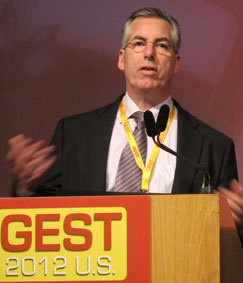
At the GEST 2012 US meeting in New York, USA, James B Spies, Georgetown University Hospital, Washington DC, USA, outlined the basic properties of spherical particles.
Spies told delegates that interventional radiologists should put any new embolics that appear on the market to the test by posing certain important questions such as: has the efficacy of the embolic been shown in a well-designed clinical study? What is the inflammatory profile of embolic? Does it load drugs, if so, which drugs and what makes it better than the embolic I am already using?
“We cannot assume that new embolics are equally as effective as current products and should insist on both in vitro and in vivo data, including clinical trial data [before switching to using new embolic agents],” he said.
Traditionally, particulate embolics meant particle polyvinyl alcohol. Then, the first spherical was introduced in 1997 in Europe and in 2000 in the USA. “The sphericals that are currently marketed in the USA are Embosphere microspheres (from Biosphere/Merit Medical), Contour SE (from Boston Scientific), Bead Block (from Biocompatibles) and Embozene (From Celonova Biosciences),” Spies added.
Characterising the difference between spherical vs. non-spherical particles, Spies explained that sphericals distribute more uniformly and more distally. They also occlude vessels of a size similar to their diameter and have been demonstrated to cause less ischaemic injury in animal models. It is also believed that inflammation associated with spherical embolics is generally less with current sphericals. “However, relatively little clinical difference has been demonstrated, at least in uterine artery embolization,” said Spies.
Sizing of sphericals
In terms of sizing, spherical particles are calibrated by size, within a given size range (for eg, 100–300µm, 300–500µm, 500–700µm). “The size range varies by product and the size of the embolic is chosen based on the presumed target size. Smaller sizes used for more distal embolization as desired in hepatic tumours. The larger sizes are used in procedures such as uterine fibroid embolization or targetedto large peritumoural vessels,” Spies explained.
Physical characteristics
Physical characteristics are the source of the greatest variation in spherical agents. Chemical composition determines hydrophilicity, surface tension, ionic charge, rigidity and elasticity. It is important to test embolics for compression (mechanical device measures the force needed to reach a fixed percentage compression) and elasticity (the speed with which the embolic regains its spherical contour after compression). “The key issues are if the spherical agent is too incompressible, compression will result in it fracturing. If the spherical agent is too compressible, it will compress once injected,” said Spies.
Other considerations while selecting a spherical embolic include knowing the histologic effect the embolic has, how much inflammation it causes, and knowing if the material is resorbed or broken down.
“It is also important to recognise if there is a clinical inflammatory reaction (such as in the case of Embogold), know how easy it is to mix and inject and have a clear idea about its cost per unit and per patient,” said Spies.
Drug loading
There are several mechanisms by which drugs are loaded onto spherical embolics. “Some are loaded by adsorption (eg Bead Block) where drug molecules that are positively charged bind to the negatively-charged embolic. A second mechanism of drug-loading is absorption (eg polyvinyl alcohol spheres) where the drug is sucked similar to a sponge. Some spherical particles use a combination of adsorption and absorption (eg Hepasphere). The mechanism of loading determines the drugs that can be loaded, he noted.
Spies also made the point that with the advances in polymer chemistry, tailored embolics are within reach. “Resorbable embolics remain a goal for many applications,” he concluded.










